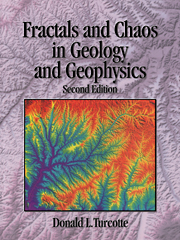Book contents
- Frontmatter
- Contents
- Preface
- Preface to the second edition
- 1 Scale invariance
- 2 Definition of a fractal set
- 3 Fragmentation
- 4 Seismicity and tectonics
- 5 Ore grade and tonnage
- 6 Fractal clustering
- 7 Self-affine fractals
- 8 Geomorphology
- 9 Dynamical systems
- 10 Logistic map
- 11 Slider-block models
- 12 Lorenz equations
- 13 Is mantle convection chaotic?
- 14 Rikitake dynamo
- 15 Renormalization group method
- 16 Self-organized criticality
- 17 Where do we stand?
- References
- Appendix A Glossary of terms
- Appendix B Units and symbols
- Answers to selected problems
- Index
14 - Rikitake dynamo
Published online by Cambridge University Press: 05 June 2012
- Frontmatter
- Contents
- Preface
- Preface to the second edition
- 1 Scale invariance
- 2 Definition of a fractal set
- 3 Fragmentation
- 4 Seismicity and tectonics
- 5 Ore grade and tonnage
- 6 Fractal clustering
- 7 Self-affine fractals
- 8 Geomorphology
- 9 Dynamical systems
- 10 Logistic map
- 11 Slider-block models
- 12 Lorenz equations
- 13 Is mantle convection chaotic?
- 14 Rikitake dynamo
- 15 Renormalization group method
- 16 Self-organized criticality
- 17 Where do we stand?
- References
- Appendix A Glossary of terms
- Appendix B Units and symbols
- Answers to selected problems
- Index
Summary
The earth's magnetic field is attributed to the electrically conducting outer core, which acts as a dynamo. The liquid outer core is primarily composed of iron, which is an excellent electrical conductor at core conditions. Electrical currents in the core generate a magnetic field. Buoyancy forces in the core, due to either temperature or composition, drive a fluid flow. The flowing electrical conductor in the magnetic field induces an electric field. This is a self-excited dynamo.
Paleomagnetism is the study of the earth's past magnetic field from the records preserved in magnetized rocks. Rocks containing small amounts of ferromagnetic minerals such as magnetite and hematite can acquire a weak permanent magnetism when they are formed. This fossil magnetism in a rock is referred to as natural remanent magnetism.
Many volcanic rocks at the surface of the earth can be magnetized because of the presence of minerals such as magnetite. When these volcanic rocks were cooled through the Curie temperature, they acquired a permanent magnetism from the earth's field at the time of cooling. Paleomagnetic studies of remanent magnetism have provided a variety of remarkable conclusions. These studies have traced the movement of the rocks due to plate tectonics and continental drift over periods of hundreds of millions of years. They have shown that the magnetic field at the surface of the earth has been primarily a dipole, as it is today, and has remained nearly aligned to the earth's axis of rotation.
- Type
- Chapter
- Information
- Fractals and Chaos in Geology and Geophysics , pp. 279 - 288Publisher: Cambridge University PressPrint publication year: 1997



